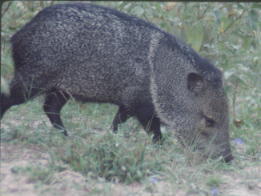
The wild boar may reach a height of 3 ft (90 cm) and a length of 5 ft (150 cm). It has 9-in. (30-cm) tusks and a fierce disposition. Now rare in Europe, it is still common in parts of Asia. The wild boar was domesticated in N Europe c.1500 B.C., and it is believed that modern domesticated hogs are descended chiefly from this European boar, with some admixture of Sus indica, a smaller Asian species domesticated in China c.3000 B.C. Hogs were introduced into the Americas by Columbus on his second voyage in 1493; in 1609 hogs were shipped to the Jamestown colony from England.
Swine are valuable for their flesh, prepared as ham, bacon, and pork, and for their fat (lard); they also provide many other products, e.g., leather for gloves, footballs, and other articles, and bristles for brushes. Hogs are commonly grouped as meat-type or lard-type, with the former dominating the U.S. farms. Hogs are raised in nearly all parts of the United States, but the corn belt of the Midwest is the chief hog-raising area, with Iowa by far the leading hog-producing state.
A great majority of U.S. hog production has moved from open pens to enclosed, mechanized facilities. The trend is toward huge, factorylike hog farms where swine are born and bred inside structures that feed, water, and dispose of wastes while controlling ambient temperature. Though hogs will eat almost any food, modern swine feed is nutritionally balanced to produce rapid and healthy growth. Based on a mix of corn and soybeans, the feed is supplemented by minerals, vitamins, and antibiotics. The giant modern farms produce enormous amounts of hog waste; this has become of increasing concern as a potential source of water pollution.
Hogs are probably susceptible to a greater number of diseases than any other domestic animal. Respiratory and parasitic ailments are major problems, particularly with limited exercise and lack of sunlight. With an estimated 65% to 85% of U.S. herds exposed to swine pneumonia viruses, drugs are increasingly important to the hog industry. Some swine diseases are transmissible to humans. Among them are brucellosis, trichinosis, and cysticercosis. The last two are supposedly the basis of the first food sanitation codes.
Classification:
Swine are classified in the phylum Chordata, subphylum Vertebrata, class Mammalia, order Artiodactyla, family Suidae.
 domestic pig |
 pecari |
 feral hog |
 wart hog |
Family Suidae Family Tayassuidae Family Hippopotamidae Family Camelidae Family Tragulidae Family Giraffidae Family Moschidae Family Cervidae Family Antilocapridae Family Bovidae<<<<<<<>>>>>>> ARTIODACTYLA CARNIVORA CETACEA CHIROPTERA DASYUROMORPHIA DERMOPTERA DIDELPHIMORPHI DIPROTODONTIA HYRACOIDEA INSECTIVORA LAGOMORPHA MACROSCELIDEA MICROBIOTHERIA MONOTREMATA NOTORYCTEMORPHIA PAUCITUBERCULATA PERAMELEMORPHIA PERISSODACTYLA PHOLIDOTA PRIMATES PROBOSCIDEA RODENTIA SCANDENTIA SIRENIA TUBULIDENTATA XENARTHRA
Email: eradani7@aol.com